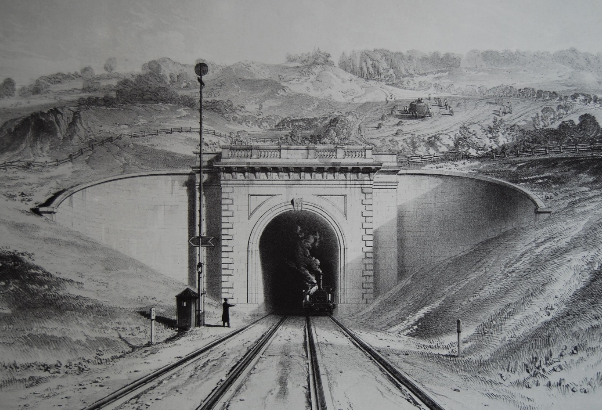A railway between Bristol and London was proposed as early as 1824 but it wasn’t until 1833 did a committee of interested persons meet in Bristol and form a company called the ‘Great Western Railway’ and appointed a 27-year engineer named Isambard Kingdom Brunel. I.K. Brunel, together with his father, Sir Marc Brunel, had engineered and built the first tunnel under the river Thames in London, a tunnel still in use today as part of the London underground system. The first Parliamentary bill was defeated but the second was passed in 1835 but there was much debate on the safety of passengers going through Box tunnel, which caused concern at the committee stage of the bill. The main thrust of the attack was, as described, ‘on the monstrous and extraordinary, most dangerous and impracticable’ tunnel at Box. Luckily Brunel was on hand to give his professional advice that passengers would be safe and not suffocated on their journey through the 3,212 yards underground at Box Hill.
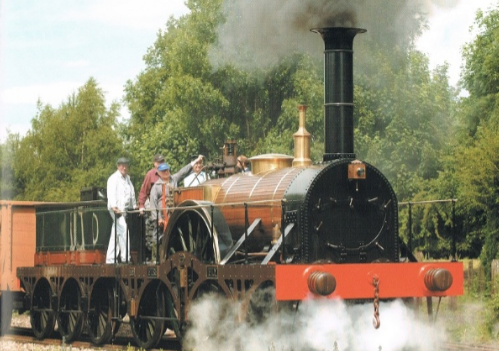
‘Firefly’, a full size replica of Daniel Gooch’s famous class of locomotives built at Swindon and probably the engine that brought the first train through Box tunnel in 1841.
As soon as the Parliamentary bill received Royal Assent, work started on building the line, which was to take 5 years to complete the 118 miles between London Paddington and Bristol Temple Meads. Work on Box tunnel was started early in 1836 with the digging of six permanent and two temporary vertical shafts varying in depth from 300 feet, at the Box end, to 70 feet at the Corsham end as the tunnel was being constructed on an incline of 1 in a 100. Work progressed steadily, but from time to time, some shafts were inundated with water and steam pumps were installed to clear the water and enable work to be continued. Approximately 1,200 men and 100 horses were employed on the tunnel’s construction but this was increased to 4,000 men and 300 horses towards the end of construction. A tonne of gunpowder and a tonne of candles were consumed weekly and during the 5-year construction period, more than 100 men were killed in various accidents.
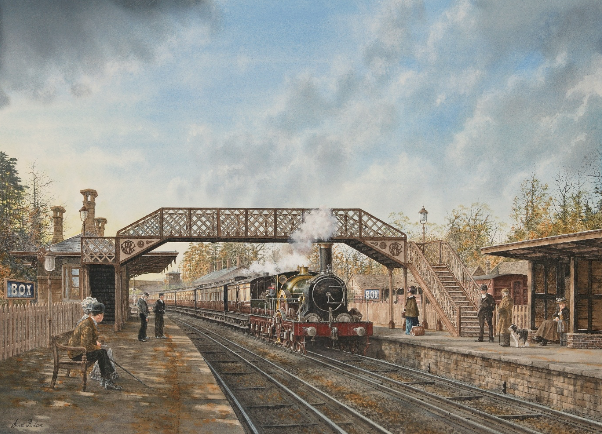
A broad gauge express from Bristol to Paddington powering through Box station in 1890. Note the footbridge, which wasn’t provided until 1884 after a number of passengers had been killed crossing the line after alighting from their train. The first station building was a temporary wooden structure and the stone building shown here wasn’t constructed until 1857. The engine is a member of the ‘Rover’ class named ‘Balaklava’, built in 1871 and scrapped at the end of the broad gauge in 1892. The water colour is by the celebrated artist Sean Bolan and appears here by kind permission of the Great Western Society and the artist.
As work on the tunnel was progressing, so was work on getting the line being constructed from Bristol to Bath and London to Chippenham. The first train from Bristol to Bath left at 8am on 30th August 1840, with much flag waving and applause. Some 9 months later, on Monday, 31st May 1841, the first train from London to Chippenham arrived with Brunel and various GWR directors and senior staff who were later entertained to breakfast by the Mayor of Chippenham and certain town worthies. A month later, on Wednesday, 30th June 1841, a train left London, bound for Bristol, and thus became the first train to pass through Corsham and onwards through the tunnel to Bath and Bristol. The cost of the tunnel in 1841 was approx. £500,000 or nearly £2,000,000 at today’s prices. Other facts and figures include that at the time of building, Box tunnel was the longest tunnel in the country. Out of the 3,212 yards that the tunnel measures, 506 yards remain today in natural stone while the remainder is brick lined. The sun does shine through Box tunnel, but not on Brunel’s birthday, April 9th, more probably on either April 6th or 7th and very occasionally on the 10th. The other myth that a secret station lies in the tunnel is certainly a myth but there is an underground lake beneath the tunnel, near to the Corsham end, and Network Rail do have an inflatable dinghy available to allow them to inspect the rail structure above the water. There’s only been one accident in the tunnel and that happened on 16th September 1893 when engine no: 3021, ‘Wigmore Castle’ broke its front axle approaching the Box end of the tunnel and derailing. No one was injured luckily, but the engine was returned to Swindon works and rebuilt, along with other members of the same class to a 4-2-2 formation to become one of the most beautiful class of locomotives ever to emerge from Swindon Works, the ‘Dean Singles’.
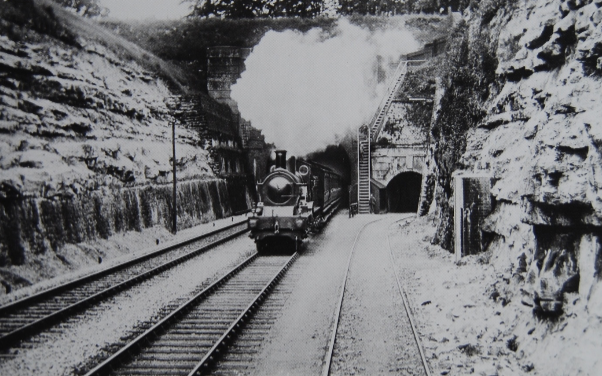
One of William Dean’s famous 4-2-2 singles of the mid 1890’s emerging from the Corsham end of the tunnel. The tunnel to the right gave access to the stone quarries of the Hartham & Yockney Stone Quarrying Company.
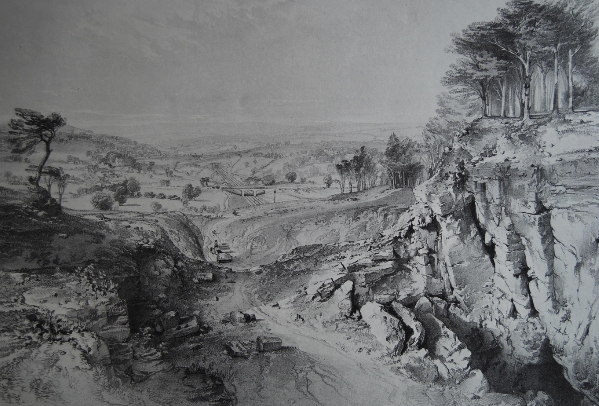
The view from Box Hill overlooking the village and the railway towards Middle Hill tunnel. Engraving by John Bourne 1846.
With the approach of electrification of the main London to Bristol line, much work is needed still to be completed with the installation of a special overhead ramp to allow the trains to take power, through the tunnel, and the upgrading of the various bridge structures for safety reasons, so there is still much to do before the first electrically powered trains appear in the Corsham/Box area.
Michael Rumsey
